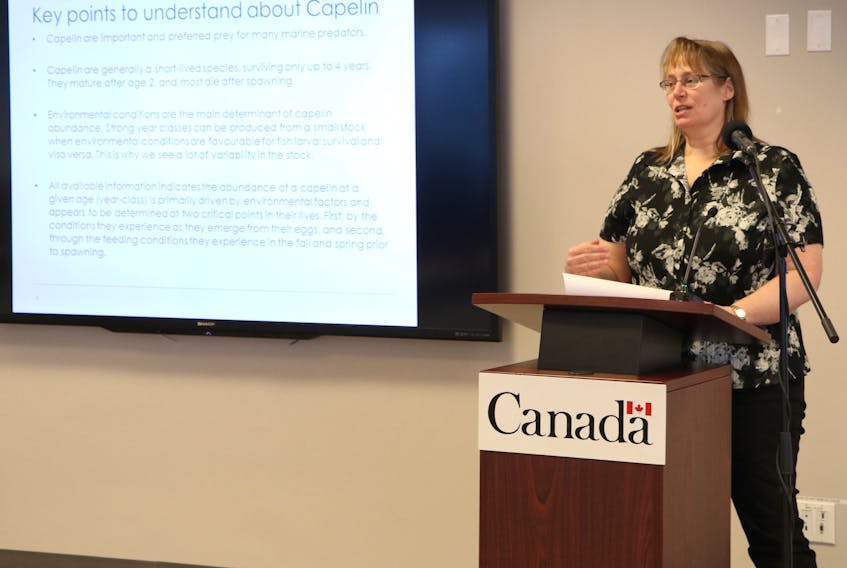From a whole school of perspectives, caplin are probably in a class of their own as the most important forage species in the waters around Newfoundland and Labrador.
A favoured food for the likes of cod, seals, seabirds and whales, and a bunch of other ocean predators, the caplin that make it through to early summer are also hit by the commercial fishery as they prepare to spawn.
The Department of Fisheries and Oceans (DFO) says up to a million tonnes of caplin are taken annually through natural predation, while the commercial fishery’s removals are small and barely impact stock levels.
Even more than consumption and removals, the state of the environment appears to be the biggest factor affecting caplin abundance, which doesn’t look good for the next two years.
“Environmental conditions are the main determinant of caplin abundance,” DFO fisheries biologist Fran Mowbray said Monday during a technical briefing for members of the media.
“Strong year classes can be produced from a small stock when environmental conditions are favourable for fish larval survival, and vice versa. This is why we see a lot of variability in the stock.”
Other than a brief period of more moderate caplin stock levels observed from 2013-2015, current stock levels have returned to the low levels typical of the post-1991 period, Mowbray said.
“Spawning times since 2015 have been delayed,” Mowbray said. “Late spawning is associated with poor larval survival.”
The spring acoustic abundance index in 2017 declined 70 per cent from 2015 numbers, Mowbray noted, providing a poor outlook for the caplin stock in 2018 and 2019.
As well, the size composition of caplin landed in the commercial fishery declined in 2017, largely due to a high proportion of Age 2 spawners. This was consistent with observations in the spring 2017 acoustic survey, she noted.
Since the early 1990s collapse of groundfish stocks in the province, there have been many who maintained that the caplin fishery should have been closed until groundfish stocks recovered.
A caplin fishery, however, has continued.
Landings of caplin in the province in the last three years were 23,065 tonnes in 2015; 27,708 tonnes in 2016; and 19,917 tonnes in 2017. The year 2016 was the only one of the three in which fishermen came close to taking the total allowable catch (TAC) set by DFO. Fishermen took 97 per cent of the TAC that year. The percentage of the TAC taken in 2015 was 81 per cent, while 70 per cent of the TAC was taken in 2017.
“At this point in time we don’t have evidence that removals of the fishery are driving (low abundance),” Mowbray said. “All reviewed information indicates that the year class strength of caplin is primarily impacted by environmental conditions.
“There are things that we’ve come to understand about what generates caplin. There’s really no relationship between the number of caplin that spawn and the number of larvae that are hatched from those eggs.
“Consumption within the ecosystem happens throughout the year, it doesn’t just happen in the one week prior to spawning as when the commercial fishery happens. The commercial fishery wants the best bang for the buck, when roe content is high and when the caplin are not feeding. Caplin feed quite aggressively during the spring right up to about a week before spawning, so the commercial fishery doesn’t open until a week before spawning. It’s a very minimal impact.”
Another thing of note is that fisheries productivity on the Newfoundland shelf has declined since the early to mid-2010s, Mowbray said. This decline was initially associated with the loss of shellfish and in the last two years includes declines in piscivores (fish that eat other fish). Despite this decline in predators, the index of fish predation on caplin increased in 2016 and 2017.
DFO assesses caplin mainly in fishing zone 2J3KL off the province’s east and northeast coast. The stock is assessed using index surveys of larval caplin and an acoustic survey of mostly immature (Age 2) caplin.
The caplin larval index is derived from sampling conducted in Trinity Bay, while the acoustic survey is conducted during May in fishing zone 3L. This survey covers the primary distribution area of Age 1 and Age 2 caplin.
Mowbray said that starting this year, DFO will carry out caplin assessments on an annual cycle instead of the previous two-year cycle.
In the coming weeks, DFO fisheries management will hold consultations with fishery stakeholders and Indigenous groups throughout the province. The TAC and any other management actions will be announced following the consultations.









